Guamanian/Chamorro vs Estonian Community Comparison
COMPARE
Guamanian/Chamorro
Estonian
Social Comparison
Social Comparison
Guamanians/Chamorros
Estonians
4,082
SOCIAL INDEX
38.3/ 100
SOCIAL RATING
205th/ 347
SOCIAL RANK
8,730
SOCIAL INDEX
84.8/ 100
SOCIAL RATING
54th/ 347
SOCIAL RANK
Estonian Integration in Guamanian/Chamorro Communities
The statistical analysis conducted on geographies consisting of 85,009,768 people shows a weak positive correlation between the proportion of Estonians within Guamanian/Chamorro communities in the United States with a correlation coefficient (R) of 0.210. On average, for every 1% (one percent) increase in Guamanians/Chamorros within a typical geography, there is an increase of 0.005% in Estonians. To illustrate, in a geography comprising of 100,000 individuals, a rise of 1,000 Guamanians/Chamorros corresponds to an increase of 4.5 Estonians.
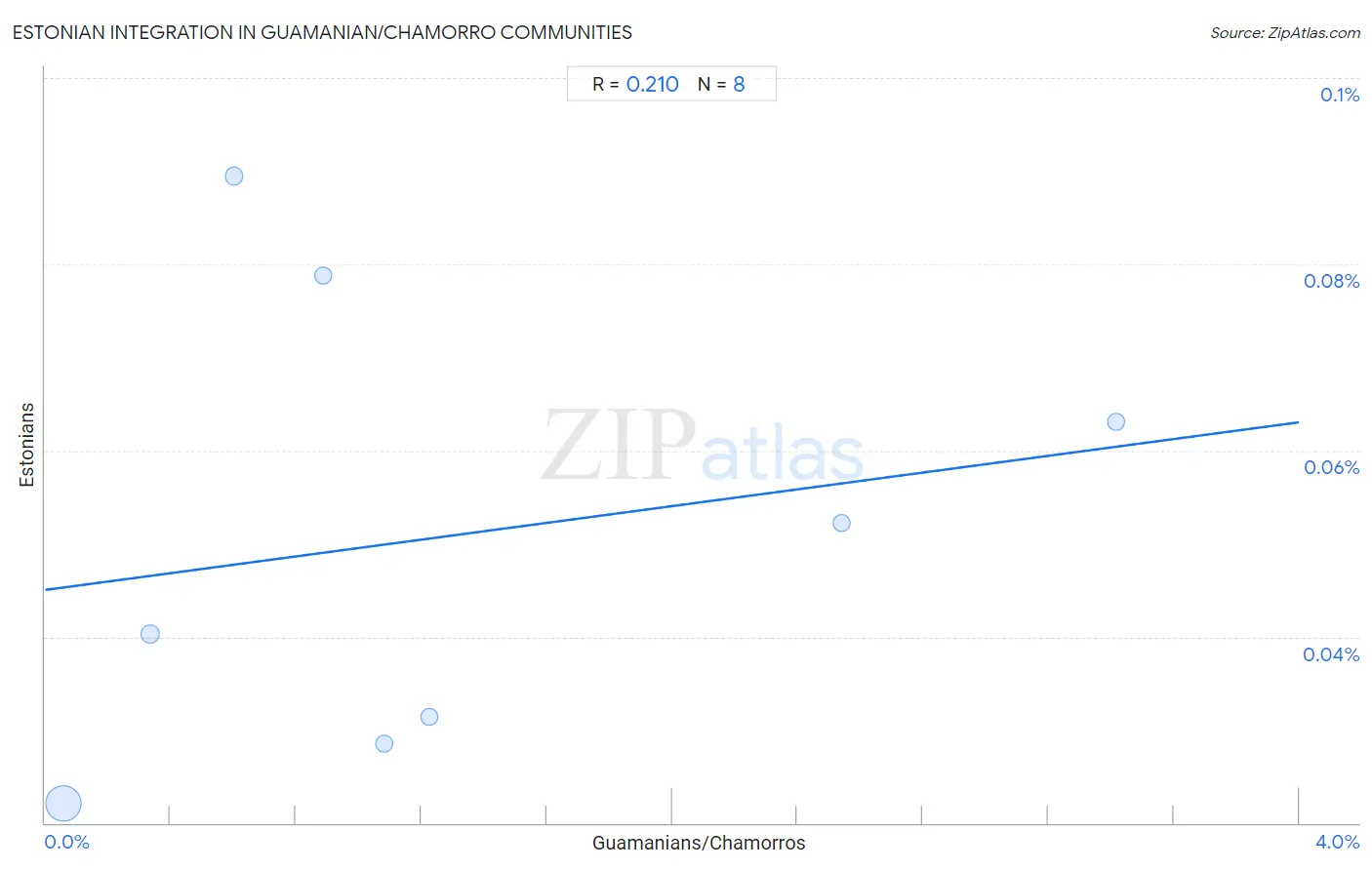
Guamanian/Chamorro vs Estonian Income
When considering income, the most significant differences between Guamanian/Chamorro and Estonian communities in the United States are seen in per capita income ($41,678 compared to $51,875, a difference of 24.5%), median family income ($101,061 compared to $118,013, a difference of 16.8%), and median male earnings ($53,661 compared to $61,710, a difference of 15.0%). Conversely, both communities are more comparable in terms of householder income under 25 years ($53,423 compared to $51,523, a difference of 3.7%), wage/income gap (26.0% compared to 27.1%, a difference of 4.2%), and householder income over 65 years ($63,187 compared to $67,926, a difference of 7.5%).

| Income Metric | Guamanian/Chamorro | Estonian |
| Per Capita Income | Tragic $41,678 | Exceptional $51,875 |
| Median Family Income | Fair $101,061 | Exceptional $118,013 |
| Median Household Income | Good $86,255 | Exceptional $95,930 |
| Median Earnings | Fair $45,933 | Exceptional $51,772 |
| Median Male Earnings | Fair $53,661 | Exceptional $61,710 |
| Median Female Earnings | Poor $38,717 | Exceptional $43,106 |
| Householder Age | Under 25 years | Exceptional $53,423 | Poor $51,523 |
| Householder Age | 25 - 44 years | Fair $93,569 | Exceptional $107,269 |
| Householder Age | 45 - 64 years | Good $101,170 | Exceptional $114,220 |
| Householder Age | Over 65 years | Exceptional $63,187 | Exceptional $67,926 |
| Wage/Income Gap | Fair 26.0% | Tragic 27.1% |
Guamanian/Chamorro vs Estonian Poverty
When considering poverty, the most significant differences between Guamanian/Chamorro and Estonian communities in the United States are seen in receiving food stamps (11.7% compared to 9.5%, a difference of 23.0%), married-couple family poverty (4.9% compared to 4.2%, a difference of 18.6%), and family poverty (8.8% compared to 7.5%, a difference of 17.4%). Conversely, both communities are more comparable in terms of seniors poverty over the age of 75 (11.6% compared to 11.4%, a difference of 2.4%), single mother poverty (29.4% compared to 27.8%, a difference of 5.8%), and single male poverty (12.2% compared to 13.0%, a difference of 6.9%).
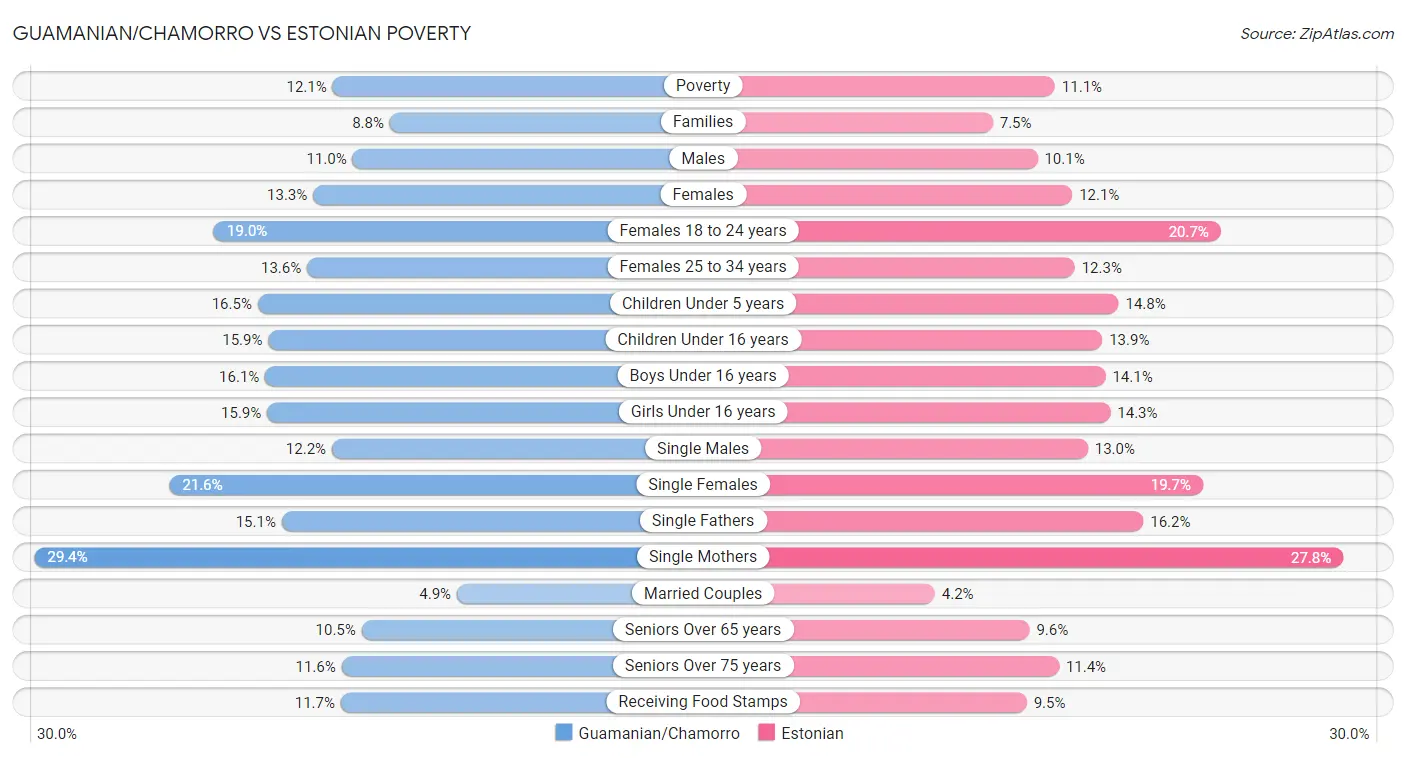
| Poverty Metric | Guamanian/Chamorro | Estonian |
| Poverty | Good 12.1% | Exceptional 11.1% |
| Families | Good 8.8% | Exceptional 7.5% |
| Males | Good 11.0% | Exceptional 10.1% |
| Females | Good 13.3% | Exceptional 12.1% |
| Females 18 to 24 years | Exceptional 19.0% | Tragic 20.7% |
| Females 25 to 34 years | Average 13.6% | Exceptional 12.3% |
| Children Under 5 years | Excellent 16.5% | Exceptional 14.8% |
| Children Under 16 years | Good 15.9% | Exceptional 13.9% |
| Boys Under 16 years | Good 16.1% | Exceptional 14.1% |
| Girls Under 16 years | Good 15.9% | Exceptional 14.3% |
| Single Males | Exceptional 12.2% | Fair 13.0% |
| Single Females | Poor 21.6% | Exceptional 19.7% |
| Single Fathers | Exceptional 15.1% | Average 16.2% |
| Single Mothers | Fair 29.4% | Exceptional 27.8% |
| Married Couples | Excellent 4.9% | Exceptional 4.2% |
| Seniors Over 65 years | Excellent 10.5% | Exceptional 9.6% |
| Seniors Over 75 years | Exceptional 11.6% | Exceptional 11.4% |
| Receiving Food Stamps | Average 11.7% | Exceptional 9.5% |
Guamanian/Chamorro vs Estonian Unemployment
When considering unemployment, the most significant differences between Guamanian/Chamorro and Estonian communities in the United States are seen in unemployment among ages 35 to 44 years (5.1% compared to 4.5%, a difference of 13.9%), unemployment among women with children under 18 years (5.8% compared to 5.1%, a difference of 13.4%), and female unemployment (5.6% compared to 5.1%, a difference of 10.5%). Conversely, both communities are more comparable in terms of unemployment among ages 55 to 59 years (4.9% compared to 4.9%, a difference of 0.35%), unemployment among ages 20 to 24 years (10.4% compared to 10.3%, a difference of 0.97%), and unemployment among ages 25 to 29 years (6.8% compared to 6.6%, a difference of 2.1%).
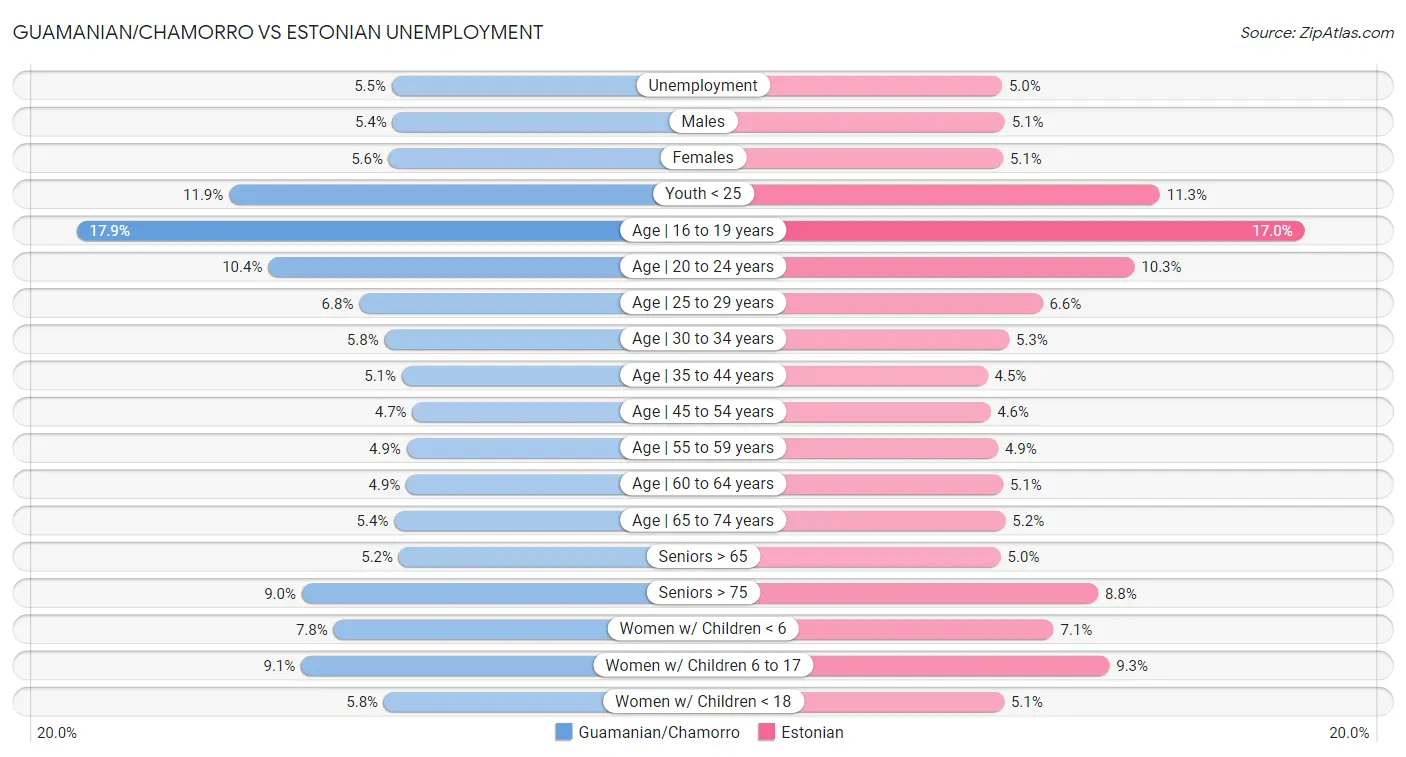
| Unemployment Metric | Guamanian/Chamorro | Estonian |
| Unemployment | Tragic 5.5% | Exceptional 5.0% |
| Males | Poor 5.4% | Excellent 5.1% |
| Females | Tragic 5.6% | Exceptional 5.1% |
| Youth < 25 | Tragic 11.9% | Exceptional 11.3% |
| Age | 16 to 19 years | Poor 17.9% | Exceptional 17.0% |
| Age | 20 to 24 years | Fair 10.4% | Good 10.3% |
| Age | 25 to 29 years | Fair 6.8% | Average 6.6% |
| Age | 30 to 34 years | Tragic 5.8% | Excellent 5.3% |
| Age | 35 to 44 years | Tragic 5.1% | Exceptional 4.5% |
| Age | 45 to 54 years | Tragic 4.7% | Fair 4.6% |
| Age | 55 to 59 years | Fair 4.9% | Fair 4.9% |
| Age | 60 to 64 years | Fair 4.9% | Tragic 5.1% |
| Age | 65 to 74 years | Average 5.4% | Exceptional 5.2% |
| Seniors > 65 | Fair 5.2% | Exceptional 5.0% |
| Seniors > 75 | Tragic 9.0% | Fair 8.8% |
| Women w/ Children < 6 | Fair 7.8% | Exceptional 7.1% |
| Women w/ Children 6 to 17 | Fair 9.1% | Tragic 9.3% |
| Women w/ Children < 18 | Tragic 5.8% | Exceptional 5.1% |
Guamanian/Chamorro vs Estonian Labor Participation
When considering labor participation, the most significant differences between Guamanian/Chamorro and Estonian communities in the United States are seen in in labor force | age 30-34 (83.5% compared to 85.9%, a difference of 2.9%), in labor force | age 35-44 (83.4% compared to 85.3%, a difference of 2.2%), and in labor force | age 45-54 (81.6% compared to 83.4%, a difference of 2.1%). Conversely, both communities are more comparable in terms of in labor force | age 20-64 (79.1% compared to 80.0%, a difference of 1.2%), in labor force | age > 16 (65.6% compared to 64.8%, a difference of 1.2%), and in labor force | age 16-19 (38.2% compared to 37.7%, a difference of 1.5%).

| Labor Participation Metric | Guamanian/Chamorro | Estonian |
| In Labor Force | Age > 16 | Exceptional 65.6% | Poor 64.8% |
| In Labor Force | Age 20-64 | Tragic 79.1% | Exceptional 80.0% |
| In Labor Force | Age 16-19 | Exceptional 38.2% | Exceptional 37.7% |
| In Labor Force | Age 20-24 | Exceptional 76.7% | Excellent 75.6% |
| In Labor Force | Age 25-29 | Tragic 83.9% | Exceptional 85.5% |
| In Labor Force | Age 30-34 | Tragic 83.5% | Exceptional 85.9% |
| In Labor Force | Age 35-44 | Tragic 83.4% | Exceptional 85.3% |
| In Labor Force | Age 45-54 | Tragic 81.6% | Exceptional 83.4% |
Guamanian/Chamorro vs Estonian Family Structure
When considering family structure, the most significant differences between Guamanian/Chamorro and Estonian communities in the United States are seen in single mother households (6.6% compared to 5.4%, a difference of 23.9%), single father households (2.6% compared to 2.1%, a difference of 23.8%), and family households with children (29.7% compared to 26.1%, a difference of 13.9%). Conversely, both communities are more comparable in terms of married-couple households (48.1% compared to 47.7%, a difference of 0.77%), currently married (47.1% compared to 48.2%, a difference of 2.3%), and divorced or separated (12.3% compared to 11.7%, a difference of 4.8%).

| Family Structure Metric | Guamanian/Chamorro | Estonian |
| Family Households | Exceptional 66.6% | Tragic 62.9% |
| Family Households with Children | Exceptional 29.7% | Tragic 26.1% |
| Married-couple Households | Exceptional 48.1% | Exceptional 47.7% |
| Average Family Size | Exceptional 3.29 | Tragic 3.10 |
| Single Father Households | Tragic 2.6% | Exceptional 2.1% |
| Single Mother Households | Poor 6.6% | Exceptional 5.4% |
| Currently Married | Good 47.1% | Exceptional 48.2% |
| Divorced or Separated | Poor 12.3% | Exceptional 11.7% |
| Births to Unmarried Women | Average 31.6% | Exceptional 29.2% |
Guamanian/Chamorro vs Estonian Vehicle Availability
When considering vehicle availability, the most significant differences between Guamanian/Chamorro and Estonian communities in the United States are seen in 4 or more vehicles in household (8.1% compared to 6.4%, a difference of 26.8%), no vehicles in household (8.0% compared to 9.8%, a difference of 23.0%), and 3 or more vehicles in household (23.2% compared to 19.7%, a difference of 17.9%). Conversely, both communities are more comparable in terms of 1 or more vehicles in household (92.1% compared to 90.3%, a difference of 2.0%), 2 or more vehicles in household (60.5% compared to 56.6%, a difference of 6.8%), and 3 or more vehicles in household (23.2% compared to 19.7%, a difference of 17.9%).

| Vehicle Availability Metric | Guamanian/Chamorro | Estonian |
| No Vehicles Available | Exceptional 8.0% | Excellent 9.8% |
| 1+ Vehicles Available | Exceptional 92.1% | Excellent 90.3% |
| 2+ Vehicles Available | Exceptional 60.5% | Exceptional 56.6% |
| 3+ Vehicles Available | Exceptional 23.2% | Good 19.7% |
| 4+ Vehicles Available | Exceptional 8.1% | Average 6.4% |
Guamanian/Chamorro vs Estonian Education Level
When considering education level, the most significant differences between Guamanian/Chamorro and Estonian communities in the United States are seen in doctorate degree (1.6% compared to 2.5%, a difference of 56.9%), professional degree (3.8% compared to 6.0%, a difference of 56.7%), and master's degree (13.1% compared to 18.8%, a difference of 43.4%). Conversely, both communities are more comparable in terms of nursery school (97.9% compared to 98.5%, a difference of 0.56%), kindergarten (97.9% compared to 98.4%, a difference of 0.56%), and 1st grade (97.8% compared to 98.4%, a difference of 0.57%).
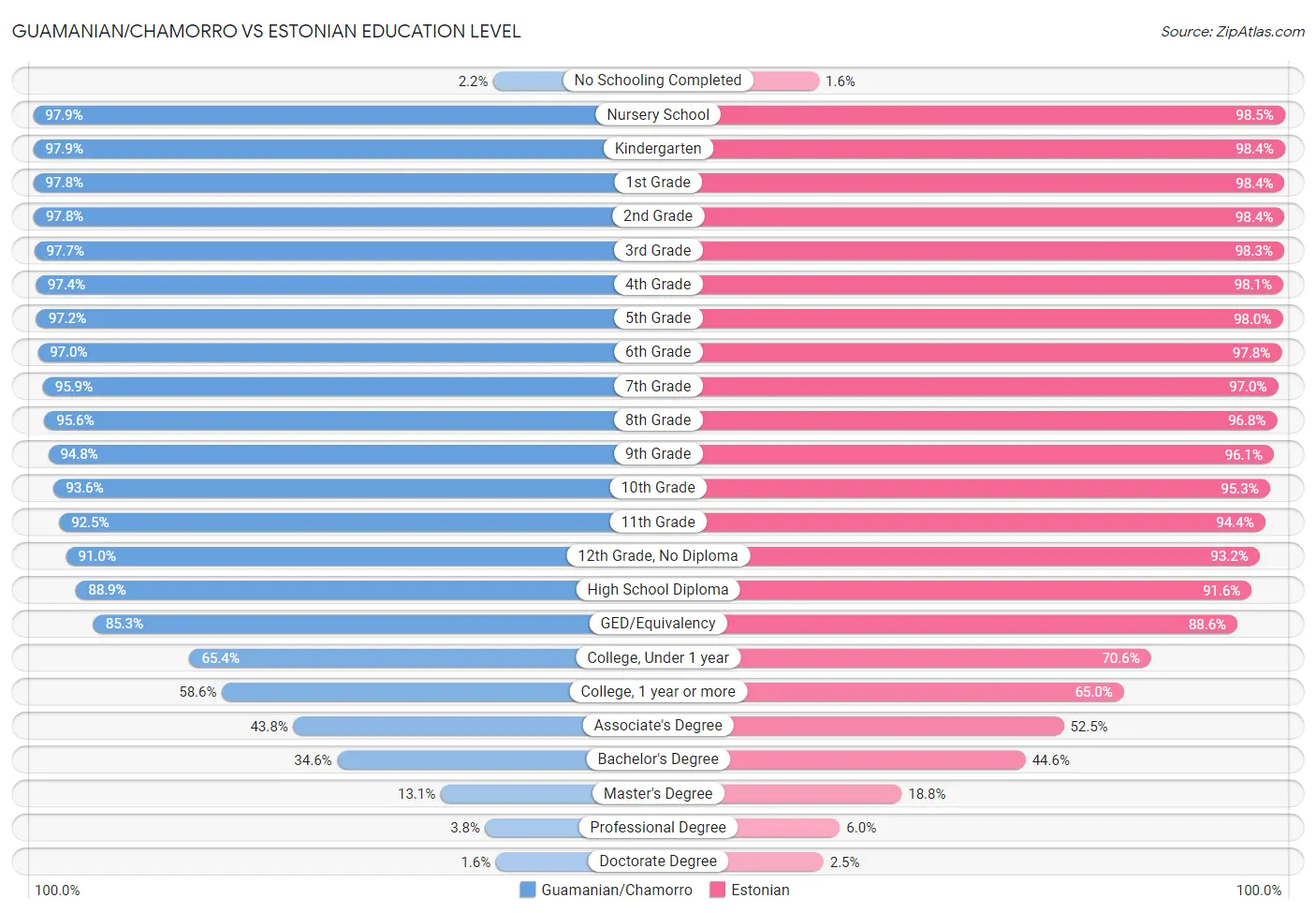
| Education Level Metric | Guamanian/Chamorro | Estonian |
| No Schooling Completed | Fair 2.2% | Exceptional 1.6% |
| Nursery School | Fair 97.9% | Exceptional 98.5% |
| Kindergarten | Fair 97.9% | Exceptional 98.4% |
| 1st Grade | Fair 97.8% | Exceptional 98.4% |
| 2nd Grade | Fair 97.8% | Exceptional 98.4% |
| 3rd Grade | Fair 97.7% | Exceptional 98.3% |
| 4th Grade | Fair 97.4% | Exceptional 98.1% |
| 5th Grade | Fair 97.2% | Exceptional 98.0% |
| 6th Grade | Fair 97.0% | Exceptional 97.8% |
| 7th Grade | Fair 95.9% | Exceptional 97.0% |
| 8th Grade | Fair 95.6% | Exceptional 96.8% |
| 9th Grade | Fair 94.8% | Exceptional 96.1% |
| 10th Grade | Fair 93.6% | Exceptional 95.3% |
| 11th Grade | Average 92.5% | Exceptional 94.4% |
| 12th Grade, No Diploma | Fair 91.0% | Exceptional 93.2% |
| High School Diploma | Fair 88.9% | Exceptional 91.6% |
| GED/Equivalency | Fair 85.3% | Exceptional 88.6% |
| College, Under 1 year | Average 65.4% | Exceptional 70.6% |
| College, 1 year or more | Fair 58.6% | Exceptional 65.0% |
| Associate's Degree | Tragic 43.8% | Exceptional 52.5% |
| Bachelor's Degree | Tragic 34.6% | Exceptional 44.6% |
| Master's Degree | Tragic 13.1% | Exceptional 18.8% |
| Professional Degree | Tragic 3.8% | Exceptional 6.0% |
| Doctorate Degree | Tragic 1.6% | Exceptional 2.5% |
Guamanian/Chamorro vs Estonian Disability
When considering disability, the most significant differences between Guamanian/Chamorro and Estonian communities in the United States are seen in disability age under 5 (1.2% compared to 1.5%, a difference of 25.6%), disability age 65 to 74 (25.3% compared to 21.4%, a difference of 18.3%), and disability age 35 to 64 (12.2% compared to 10.6%, a difference of 15.2%). Conversely, both communities are more comparable in terms of hearing disability (3.3% compared to 3.3%, a difference of 0.17%), female disability (12.5% compared to 12.0%, a difference of 4.1%), and disability (12.3% compared to 11.7%, a difference of 4.9%).
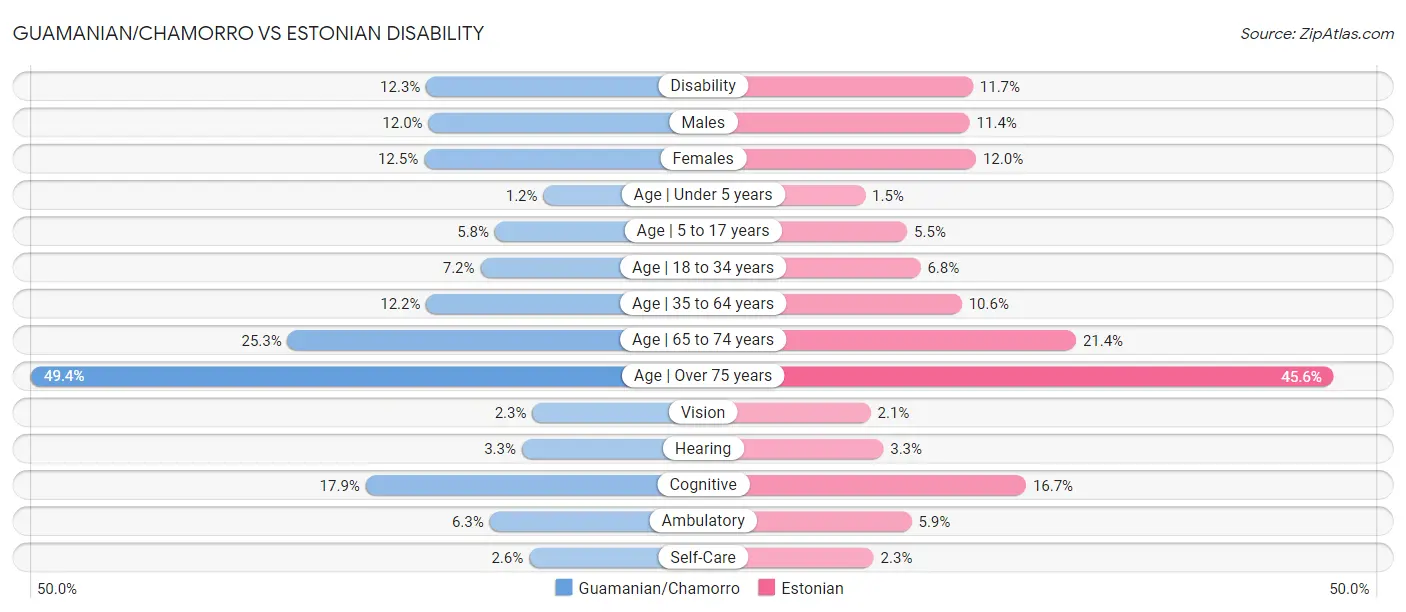
| Disability Metric | Guamanian/Chamorro | Estonian |
| Disability | Tragic 12.3% | Average 11.7% |
| Males | Tragic 12.0% | Fair 11.4% |
| Females | Tragic 12.5% | Excellent 12.0% |
| Age | Under 5 years | Average 1.2% | Tragic 1.5% |
| Age | 5 to 17 years | Tragic 5.8% | Excellent 5.5% |
| Age | 18 to 34 years | Tragic 7.2% | Fair 6.8% |
| Age | 35 to 64 years | Tragic 12.2% | Exceptional 10.6% |
| Age | 65 to 74 years | Tragic 25.3% | Exceptional 21.4% |
| Age | Over 75 years | Tragic 49.4% | Exceptional 45.6% |
| Vision | Tragic 2.3% | Exceptional 2.1% |
| Hearing | Tragic 3.3% | Tragic 3.3% |
| Cognitive | Tragic 17.9% | Exceptional 16.7% |
| Ambulatory | Poor 6.3% | Exceptional 5.9% |
| Self-Care | Tragic 2.6% | Exceptional 2.3% |